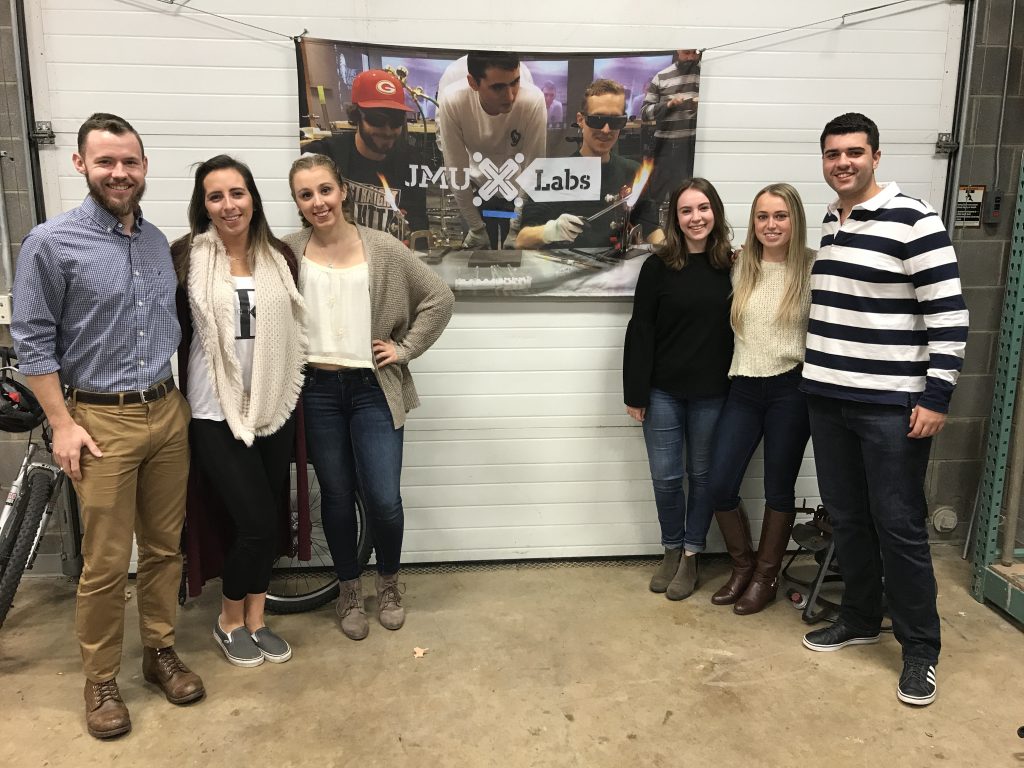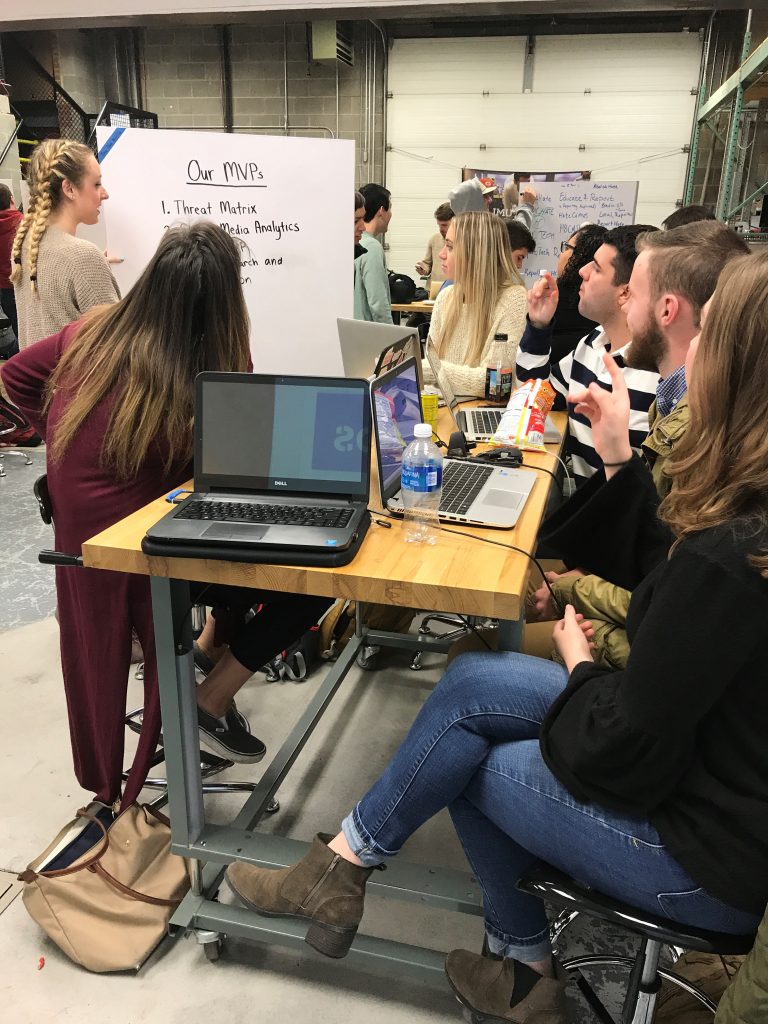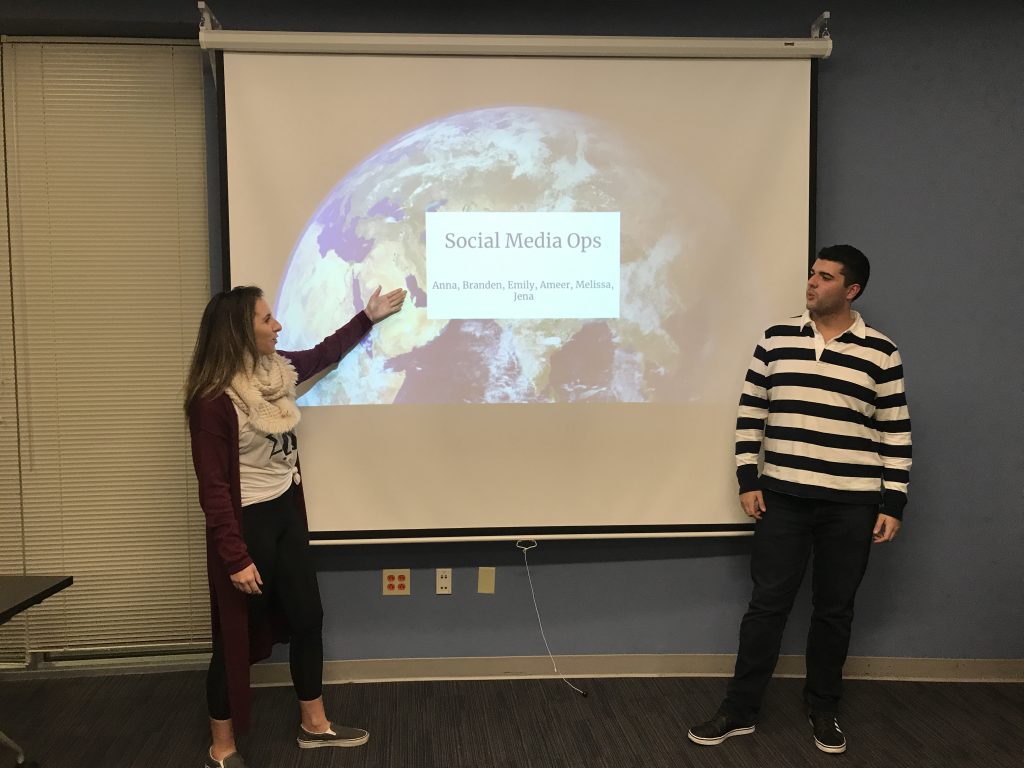Week 5 (10/31 – 11/7)
Hacking Social Media Escalations
What problem has SOCOM challenged us with solving?
Our team, Social Media Ops, has been working with the United States Special Operations Command (SOCOM) this semester on a social media escalation problem. Our sponsor has tasked us with creating a way to monitor information warfare on various social media platforms, with a special focus on social unrest in North Africa. We have been asked to create an early detection system that monitors unrest and threats on social media using trigger words, hashtags, geospatial recognition and various other features to prevent conflicts, radicalization of individuals and threats to nations as a whole. We have also been tasked with configuring a way to use social media analytics to develop counter-narratives toward protagonistic and antagonistic messages. A solution would empower SOCOM, as well as their teams internationally, to monitor and mitigate threats at a global, national and local level to better serve and protect people around the globe.
What is SOCOM and who is our mentor?
SOCOM is an organization within the Department of Defense that oversees a multitude of Special Operations branches within the various military branches. Their headquarters is located at the MacDill Air Force Base in Tampa, Florida. Their main responsibilities include: developing special operations strategies, monitoring the special operations assignments, personnel, education, retention and acquiring the equipment, materials, supplies and services to carry out missions. They provide combat-ready forces for rapid reinforcement of other unified commands worldwide. Our SOCOM mentor’s names and titles shall be kept anonymous for confidentiality reasons, however, they work within a branch that focuses on countries in North Africa. Our JMU mentors include LTC. Nick Swayne, director of the JMU X-Labs who served in the U.S. Army Psy Ops, and Dr. Kathleen Moore, a professor within the Intelligence Analysis major at JMU. If you would like to read more about SOCOM, please visit their website here.
What research did our team conduct?
We began by interviewing Intelligence Analysis professors at JMU to learn about social media trends, predictive analytics, cyber intelligence and counter-messaging. This was our stepping stone into understanding how social media analytics works and how to monitor it. After interviewing representatives from government agencies including SOCOM employees (both former and present), the Department of Homeland Security, Booz Allen Hamilton, a Political Officer at a US Embassy and a Political Communications Director for the United States Congress, we gained more background information about the scope of our problem and the nature of information warfare as well as tasks of political analysis in international affairs.
Our later interviews focused on the culture and technology in North Africa, as we believed that it was essential to understand the region, culture, and threats that individuals face. We interviewed the Program Director at EdVenture Partners who manages the Peer to Peer program conducted with international students. These students created social media campaigns and counter-narratives to threats in their home countries. To read more, click here. We heard personal insights on their regions and our current approach to solving our problem. We also interviewed an Imam who had personal experience in Sudan.
Our final interviews included a JMU employee who specialized in social media analytics/tracking of posts at JMU, a team from the Extremely Together Initiative at the Kofi Annan Foundation, which created a campaign on preventing and countering violent extremism around the globe, a CNN reporter with extensive field experience and the social media analytics companies Babel Street and Convergent AI, who track and gather social media data for assessment and predictive analysis. Overall, we conducted 36 total interviews with 32 different individuals.
Major Pivots:
Originally, we had a broad problem statement that was left up to interpretation. We quickly reached out to SOCOM for clarification to narrow our research, and were tasked with a focus on North Africa. This drastically shifted our approach, considering a rural community in the United States is different than one in Africa. We speculated how to identify these communities, monitor their social media, and effectively help SOCOM push their agenda.
Our initial plan was to create a social media analytics platform capable of searching social media for threats with trigger words, specific users, and geographical locations. We questioned our ability to actually create this type of program. Thankfully, Dr. Moore informed us that there are actually several companies that already have these capabilities. We decided to suggest a partnership between SOCOM and an existing platform. We discovered that SOCOM is already partnered with Babel Street. Rather than suggesting that they just extend their partnership, we decided to still include Convergent AI in our report because they possess a unique early detection capability for predicting terrorist attacks.
After interviewing several government agencies, we had an ah-ha moment that rather than just focusing on the social media monitoring of countries, we needed to focus on a topic that could be tracked through social media, such as a social movement, and assess how they arise, progress and the resolutions that follow. The predictive functions of a social media analytics tool could search trigger words that correlate with unrest or threatening posts, and monitor the social movement. We decided to create our own threat matrix of social movement progression. We researched social movements around the globe and in our region of focus to assess the premise of this matrix at a global scale and avoid bias in our research.
After another meeting with Dr. Moore, we were introduced to the idea of using bots to tackle counter-messaging. Previously, we considered providing educational tools on preventing extremism to rural communities to help them create their own counter initiatives and messages. This revelation on bots appeared to be a more effective way to monitor threats.
Our Final MVPs (Minimum Viable Products)
The research combined led to the creation of our three final MVPs. A minimum viable product is the simplest prototype possible. It is developed quickly, inexpensively, efficiently and is used to test a hypothesis in order to best understand the intended user’s interest. Our first MVP suggests a partnership between SOCOM and our suggested social media analytics platforms. Since Babel Street is already partnered with SOCOM, we believe that their contract could be extended to our sponsor’s branch to help them track/ gather data on all social media platforms. However, since Babel Street doesn’t have the ability to perform early detection, we are also suggesting that SOCOM partners with Convergent AI, since they possess an early detection system. An early detection system would detect a social movement before it occurs, which could help to avoid conflict and send effective counter-messages.
Our second MVP is our threat escalation model. It includes the four stages of a social movement which we define as: Dissatisfaction, Manifestation, Formation and Implications. This is based upon what we found studying sociology textbooks; however, we made our own modifications. We added indicators of the stage on social media and transitions that explain signs that a social movement is in a certain step and when it is phasing to the next step. Additionally, we included examples of social movements from several countries to provide a better understanding of how social movements evolve and how they could fit into our model.
Our final MVP is an explanation of bots and their capabilities. Bots are applications that perform automated tasks, such as googling information, ordering food and disseminating messages to large groups of people. They can be disseminated as automated messages, such as emergency amber-alert like notifications, or they can be user-friendly where the individual has the opportunity to navigate and interact with the bot to receive information and messages. Our group believes that bots would be an effective way to disseminate messages to the public in both urban and rural areas using social media, and that they could effectively respond to existing threats or monitor and prevent future threats.
The Value of an Interdisciplinary Team:
Our team is composed of six students whose majors span across seven different disciplines of study. This includes Intelligence Analysis, International Affairs, Public Policy and Administration (PPA), Engineering, Communications, Writing, Rhetoric and Technical Communication (WRTC), and Sociology. This versatility created a unique learning environment that has helped us complete our project more efficiently and strategically. The Intelligence Analysis and International Affairs majors are skilled in analytical terminology and a knowledge of the international conflicts we researched, which has been beneficial in creating our threat matrix and bot research. The PPA major possesses a thorough understanding of government structure and contributed multiple connections for interviewees within government agencies. Our engineer is skilled with using technology and piecing together the parts of our solution which was beneficial in finalizing our MVPs. The Communications major has refined public speaking skills, established strong relationships between our group members, and brought creativity to our team, which helped create a welcoming group atmosphere for ideas. The WRTC major brought strong editing skills for refining our writing submissions and, lastly, our Sociology major provided a skilled understanding of the way people interact and respond in social conflicts, which was beneficial in deciphering the best way to send a message to the public. These disciplines have created a strong, resilient team. We have been able to construct strategic, unique and intellectual ideas and articulate them efficiently to our audience, which ultimately made our group extremely successful throughout our journey.
From Problem to MVP
Our Sponsor & Mentor
We are in collaboration with the Aspen Institute’s Financial Security Program (FSP). The Aspen Institute is a non-partisan policy studies organization with over 50 programs dedicated to tackling critical issues. The FSP, the program our team is sponsored by, was created as a preeminent initiative to investigate policies or services that could create greater financial security for millions of American households. Their purpose is to capture leading voices within all sectors of the American financial landscape to create palpable, innovative change to improve the financial well-being and security of Americans.
Our mentor is Austin Hinkle, a Senior Policy Advisor at the United States Treasury Department. Austin has experience working with financial regulation and provided guidance throughout the project which was instrumental in helping us narrow the scope of our problem and helping us understand the regulatory perspectives.
Our Problem
Our team was initially faced with the challenge of identifying ways in which Financial Technologies, or FinTech, could be used and regulated to benefit low and volatile income Americans. After conducting eight weeks of research into these topics and interviewing a variety of professionals from within the fields of finance and regulation, we narrowed the scope of our problem to focus on the field of small-dollar lending. Therefore, our problem evolved into how to increase both consumer and regulators awareness and understanding of small-dollar lending options available to consumers with a focus on maximizing consumer benefits attained from those services.
Our Solution
The final iteration of our minimum viable product (MVP) is a survey-based tool which operates as a matchmaker for consumers looking for small-dollar loans and lenders, whether those lenders be online (website or application) or physical “brick and mortar” lending institution. The tool surveys consumers based on the importance they place on various criteria related to small-dollar loans, such as the value they place on the timeliness of the loan, frequency of which they expect to take out small-dollar loans, and face-to-face interaction. The survey then collects the data on the consumer’s values and preferences and uses those rankings as weights to calculate what types of lending services most and least closely align with the consumer’s needs and preferences.
Our MVP will benefit consumers looking to obtain small-dollar loans by informing them of loan provider options alternative to payday lenders which may better suit their personal needs. It will also give them a stronger understanding of the lending services available on the market as a whole, so they can make the most informed decision about where to take out their loan. Further, because our product is focused on understanding consumer needs and creating recommendations based on those needs, the survey tool could also serve secondarily as a tool to increase awareness of consumer needs and available products that fit those needs among regulators and policy-makers involved in small-dollar lending. This heightened understanding of these needs and options will allow policy and regulation to be shaped by benefits to the consumers that are using these small-dollar lending services in the first place.
Research, Processes, and Major Turning points
Over the course of eight weeks, our team conducted 40 interviews with 34 different people. We broke our research subjects into five categories: our sponsor, our mentor, professors with a research focus in the fields of finance and regulation, professionals working in the fields of finance and regulation, and other people who do not fit into the aforementioned categories. The chart to the right shows the percentage breakdowns for how many interviews fell into each of these categories. Within the category of “professionals”, more specifically, we interviewed a California State Regulator who helped us see that there may be a knowledge gap regarding the link between the types of alternative financial services such as FinTechs on the market and how they could benefit low and volatile income consumers specifically.
Aside from interviewing other people with expertise in the industries of finance and regulation, we also conducted extensive outside research to help us better understand various facets of the field and problem we were working on. Early in the process, we conducted cross-national research to determine examples of global “best practices” for where FinTechs were successfully being used and regulated outside the United States. This research was inspired by an interview with one of our sponsors from the FSP who helped us start to understand FinTech regulations abroad and filled us in on what the regulatory landscape looks like in the United States. Based on this, he also helped us see what the US regulatory landscape could look like based on models from other countries. Expanding on this information, each team member was assigned a region based on five continents–North America, South America, Europe, Asia, and Africa–and within each region, we pinpointed specific countries and examined the social, political, and economic factors that affected the diffusion of and regulatory environment surrounding FinTechs within the country. This information helped orient us within the field of FinTech and regulation on a broad scale and allowed us to understand some of the potential assets and barriers for FinTechs within the United States based on these global comparisons.
Another important point of research focused on understanding the low and volatile income consumers that our problem was targeted at helping. Through this, we learned that there are often misconceptions about who these consumers are, with people incorrectly assuming low and volatile income consumers are irresponsible or incompetent in managing their finances. Our research indicated that this is not the case, and in fact, the percentage of Americans that qualify as low or volatile income is much higher than many might initially expect and reaches well into what would be considered the American middle class. For further reading on this topic, check out The Financial Diaries by Jonathan Morduch and Rachel Schneider and The Unbanking of America by Lisa Servon.
A major pivot in our project scope and research came in week four during an interview with our mentor, Austin Hinkle. During this interview, Austin helped us realize that we needed to narrow the scope of our problem, and we initially decided to narrow into investigating credit and ways alternative lending services could help build credit scores. Though this did not remain the final focus of our project, the shift to credit eventually put us on the path of examining the various types of small-dollar lending services and the different benefits and pitfalls they each offer consumers.
Interdisciplinary Teamwork
It has become evident in today’s society that problems are not confined to a single discipline; complex problems are continuously developing that are characterized by a need for strong interdisciplinary efforts towards viable solutions. Although working on the socio-political issues facing the FinTech industry and millions of Americans was initially daunting for a group with little direct experience within the finance and regulatory fields, the interdisciplinary nature of our team allowed us to develop an understanding of the problem from an outside perspective and present valuable insight in this given context. Drawing from seven different fields of study across the university, our team was able to research, develop, and refine potential solutions utilizing the diverse background of each member’s academic interests.
Working as an interdisciplinary team has proven to be extremely valuable for our work; each team member has the ability to provide valuable insight from his or her field of study that helps mold our research and project solutions in a positive direction, and our group has also utilized individual strengths in a flexible, effective way. For example, Aaron’s engineering background proved invaluable when designing our MVPs as he drew on engineering tools such as the Pugh chart and decision matrix, both used to make informed decisions based on weighted criteria. These engineering tools influenced the shape of our final MVP. Aside from different knowledge bases, the seven different fields of study we cover as a team also gave us a variety of types of thinkers. Among the group, we have big-picture thinkers, critical thinkers, global thinkers, and detail-oriented thinkers, which all functioned as different lenses through which we saw and understood facets of our problem, thus contributing to a more nuanced, holistic view of the problem when examined together.




Recent Comments